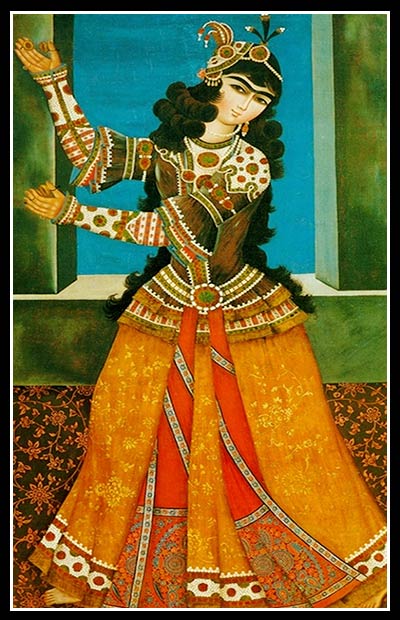The Qajar painting school:

The painting of Qajar style has all the thematic and practical features of a painting school.
This style of Qajar painting is a combination, in which the characteristics of the traditional Iranian painting and Western painting techniques painting are clearly seen. The Qajar painting was formed by combining traditional Iranian painting with elements and methods of European painting.
Although paintings similar to this style of the Safavid period, known as Farangi Sazi were popular in Iran, but this style of painting first developed more during the Zandian period and then during the Qajar period.
During the Qajar period, the art of painting was mostly influenced by courtiers, and kings and princes were the most important clients of paintings, and they were the only supporter of the art of that period.
During the reign of Fath Ali Shah, the style of mural painting began. Among the beautiful murals of Agha Mohammad Khan and Fath Ali Shah, in the ruins of Kushki in Karaj are examples of Qajar-style murals.
The Qajar School of painting actually began during the reign of Karim Khan Zand, and during the reign of Fath Ali Shah of Qajar, suitable conditions were again provided for the revival of the art of the courtiers.
The Qajar king brought together some of the most prominent painters of the period in the capital and commissioned them to paint on large curtains for installation in new palaces.
In the Qajar school of painting, different styles such as landscaping and ornamentation were beautifully adapted to each other and created a new style. The Qajar dynasty and kings ruled in the early thirteenth century on the ruins of the realm of Karim Khan Zand.
The first years of Fath Ali Shah’s reign coincided with the Napoleon Wars in Europe, and there was a political conflict between Britain and France at the Iranian court. Therefore, the connection with European countries and the familiarity of Iranian painters with European painting styles, created a new style in Iranian painting during the Qajar period.
The Qajar painting began in the early nineteenth century and continued until the early twentieth century.
In the early days of Nasser al-Din Shah’s reign, painters combined techniques of European painting with traditional painting style.
The combination of these new and old methods of painting led to the creation of new style paintings that were completely Iranian. During this period, Qajar painting was transferred from paper to canvas, and the Iranian style of painting on canvas began.
The portraiture painting is one of the main themes in Qajar painting and a considerable number of this style of painting have been painted for installation in official and public places by order of courtiers and ministers.
The paintings in standing position, sitting on a chair, two knees sitting, special decorations on clothes, swords and their jewelry hats … and paintings of this type have been painted by order of Qajar princes and their other relatives. In the paintings of the Qajar period, the importance of portraits and details of the court character of princes is clearly visible.
Another type of Qajar period painting style that has been used to decorate pen boxes, mirror frames, make-up boxes and other decorative objects is called oil lacquer painting. Also, the painting of flowers and birds that began in this period and the late Safavid period became more common in the Qajar period.
Introducing the painters of Qajar period painting school.
Famous Qajar painters include:
Sani-al-doleh, Abolhassan Khan Ghaffari, Kamal al-Molk – Mohammad Ghaffari and Mahmoud Khan Malek al-Shoara – Saba. The painting of the story of One Thousand and One Nights, the painting of Lily and Majnoon and the paintings of the Iranian government newspaper are among the works of Sani Al-Molk.
One of the most prominent works of Kamal al-Molk is the painting of the Hall of Mirrors, the Jewish Falgir and the sunset of Shemiran. Also, the painting of Mahmoud Khan Malek al-shoara is one of the paintings of the Qajar period.
Abu Torab Ghaffari and Mirza Musa are also among the other painters of the Qajar School.
Dear visitor, if you are interested in Iranian painting, you can visit the collection of paintings, which has been painted by an Iranian artist.
Please click on this: The collection of traditional Iranian paintings.
© KHorshid Artworks Collection.
